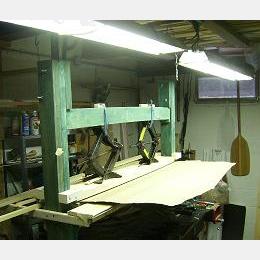|
For a quick pictorial overview of this project hop to page 12:
12 Pictorial Overview
|
>
Having an interest in building a birch bark canoe but knowing I have no
chance of getting birch bark and also having an interest in paper canoes
I decided to try to build a paper canoe in the style of a birch bark canoe.
I purchased a roll of building paper (35" in width) and did some experiments
on gluing strips of paper each the same size together (35" by 3").
I did not find an adhesive that was non-water base that gave good adhesive
strength yet was not too expensive. Non-water base adhesive have the advantage
in that they do not wrinkle the paper.
|
|
When using water based adhesives I found that gluing narrow strips together
required moderate clamping pressure in order to get the strips flat; that is
without wrinkles.
On gluing a strip of paper (3.25" by 35") on a larger base (24" by 35") wetting
the base by the wet stip resulted in many wrinkles do to the base paper in the
strip area expanding lengthwise while the rest of the paper did not. To over
come this problem even more clamping pressure is required. A strip 35" when well
wetted expands to 36" in length.
In order to apply that much pressure to interior of a large sheet of paper requires
some type of press. I built a press from wood (mainly doubled lengths of 1.5" by
3.5") and used two automobile jacks to supply the pressure.
|

|
|
Within the press there are two wooden pressors that are forced together by
automobile jacks.
To prevent the pressors from absorbing water from the glue (through the wetted
paper) they need to be covered in plastic else they will bow.
But on the other hand something has to absorb the water from the glue; so a
strip of plywood is used on top of the paper to absorb the water (the pressor
foot). This 1/4" * 5" * 47" strip of wood can also be preheated to help in the
drying process. By having two pressor feet one can be drying and warming while
the other is in use.
|
